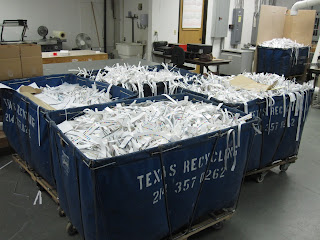- Itek 975
- Ryobi 3302
- Hamada B452A
- Heidelberg Speedmaster
The Itek 975 is from the 1980s but is a workhorse. It does 2-color printing of envelopes for us.

The Ryobi 3302 does letterhead and 2-color jobs from 8 1/2 x 11 to 11x17 inches.
Only 5 years old, the sheet-fed Hamada handles volumes up to 9,000 sheets per hour. Able to do 4-color work, it is an automated plating machine and handles paper up to 14x20 inches.

The largest and most complex machine in our inventory is the Heidelberg. This sheet-fed machine handles paper up to 20x28 and up to 11,000 sheets per hour. Long runs and larger (catalogs, etc) are produced on this machine.

These four machines give us flexibility and capability few others can match.
The Executive Pressman



